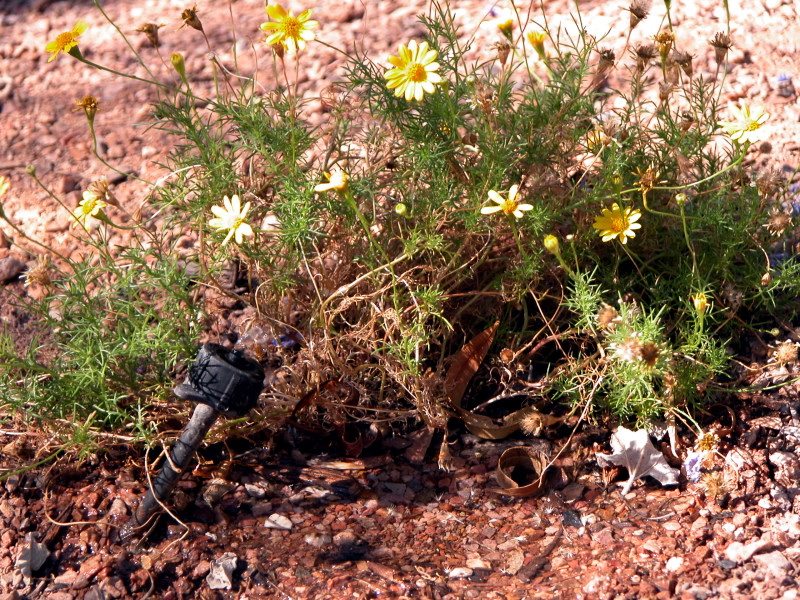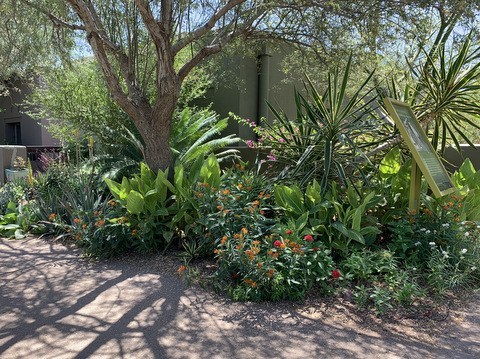Summer is here. Residents of the Southwest are no strangers to the heat, which not only affects our comfort but can be difficult for the plants in your garden. Thankfully, there are several things you can do to help your garden weather the heat of a Southwest summer.
Southwest Gardening’s Noelle Johnson lives in the Phoenix area where summertime temperatures can rise over 110 degrees F. Despite the extreme temperatures, her garden thrives, as do her clients’ gardens. Here she shares her top 5 tips to help your landscape get through this hot season:
1. Water plants deeply

It’s no surprise that plants need water to get through summer. However, frequent, shallow watering can do more harm than good. Plants need to be irrigated deeply and there are several reasons for this. First, deep watering encourages the roots to stretch deeper where the soil is cooler and stays moist longer. It also helps to prevent the natural salts present in our soils and water from accumulating around the root zone. Shallow watering often leads to salt-buildup, which is evident by a white powdery substance on the soil surface.
Third, and most importantly, watering deeply is a more efficient way to keep your plants healthy because it decreases the frequency with which you need to irrigate. Why? Because the soil stays moister longer and doesn’t dry out as quickly. In Noelle’s garden, she follows the recommended depths for watering as recommended by the folks at Water – Use It Wisely [Thanks for the shout-out Noelle]. This information is available on their website, which you can access here.
2. Provide shade for sun-sensitive plants

When we think of shade, a lovely shade tree often comes to mind. However, dense shade can make it difficult for many different types of plants to grow. The filtered shade is best because it lets in enough sunlight to allow a large variety of plants to grow underneath their branches. Desert trees that provide this type of shade include desert willow, ironwood, mesquite, and palo verde, to name a few.
Sometimes, plants need temporary shade during the summer months. This can include those that have been recently planted and that haven’t had time to adjust to full sun. Alternatively, there are some plants that can’t handle the full sun of the Arizona and California desert summers. This includes tomato plants as well as some succulents. Shade cloth is a great tool to help provide plants with temporary shade.
3. Add mulch around the root zone of plants

There is so much to love about the benefits of adding mulch to your garden. For the summer garden, in particular, mulch keeps soil from drying out too quickly while reducing soil temperatures. Another desirable effect is that it reduces weeds.
There are two types of mulch — organic, which is made up of materials such as bark, and mineral mulches like crushed stone or landscape rock. Both have the same benefits as described earlier. However, organic mulches improve the soil as they decompose, releasing nutrients.
When applying mulch, it’s important to spread it throughout the root zone of plants, which can extend beyond the reach of its branches. A typical depth of mulch is 3 inches. Here is a word of caution when using organic mulches — keep the mulch 6 inches away from the base of trees or woody shrubs. Not doing so can promote the growth of harmful fungal diseases or the presence of undesirable insects.
To learn more about mulch, check out this great post by SWG’s Ann McCormick.
4. Water early in the morning

Just as the depth of watering is essential, so is the time of day when plants are irrigated. Drive down any neighborhood in the middle of summer and you’ll undoubtedly see sprinklers running in the middle of the day. So, why does the time of day matter when irrigating plants?
First, summer days are stressful for plants. The sun causes plants to lose water through their leaves and plants use all their resources to deal with the stresses that the heat brings. As a consequence, they don’t have resources available to take up water. In the case of using sprinklers to water your lawn, doing so during the day is wasteful. The reason for this is that up to 50% of the water is immediately lost to the atmosphere on a sunny day and doesn’t benefit the lawn.
It’s best to water plants early in the morning throughout the year, but especially in summer. This allows plants to take up the water when they have resources available.
5. Use native or desert-adapted plants that thrive in the heat

One of the easiest ways to have a garden that can weather the extreme heat of a Southwest summer is to select plants that can handle it. There are a surprisingly large number of plants that can thrive in hot temperatures. What often causes problems is when people try to grow plants that are ill-suited to hot, dry summers and have to coddle them through the summer months.
If you are wondering what type of plants to add to your garden that can handle the heat, we have a free guide available for you called “20 Plants That Can Take the Heat”.
Having an attractive garden that looks great all summer long with little fuss is possible if you follow these tips.
Other articles or pages of interest:
This blog originally appeared on June 5, 2019, and is being reprinted with permission. Water – Use It Wisely is proud to feature guest bloggers who write about topics related to water and water conservation. The author of this blog, Noelle Johnson, is an urban horticulturist, Certified Arborist and freelance garden-writer who helps people create beautiful, low-maintenance gardens through helpful advice on her blog www.azplantlady.com. She is passionate about teaching people about the amazing desert plants that thrive in our landscapes.


